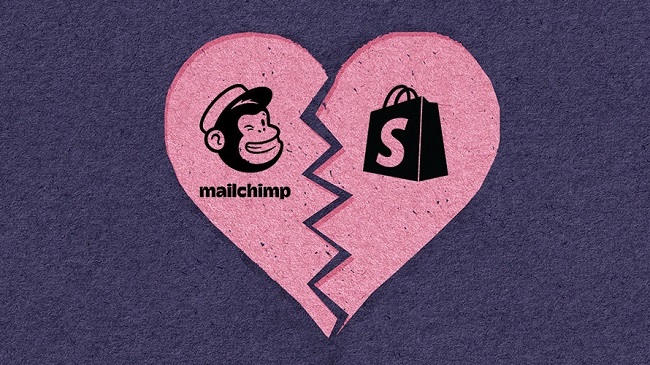Richard Burton and Elizabeth Taylor, Cher and Sonny Bono, Kermit the Frog and Miss Piggy…Mailchimp and Shopify. Do you see a pattern? It’s an unfortunate one, but a pattern nonetheless: breakups. While we could go on and on about the unfortunate reality of relationships—they can only end in one of two ways—and how sad it is that our favorite celebrity couples rarely end up together, our discussion today will take a more marketing-oriented approach and consider what the titular break up of our post means.
The Breakup of Mailchimp and Shopify
Now that the initial shock has gone down, the breakup of Mailchimp and Shopify looks a lot like a ‘he said, she said’ situation, with each side disavowing any wrongdoing on their part. Typical. So, what led to the separation? In typical 21st century / digital age fashion, it all comes down to customer data. According to Mailchimp (the most important bits are in bold):
“[On March 22nd], we asked Shopify to remove the Mailchimp for Shopify integration from their marketplace. We made this decision because Shopify released updated terms that would negatively impact our business and put our users at risk.
We also asked Shopify to leave the integration on for existing connected users through May 12, when the data sharing provisions of Shopify’s new terms take effect. We’re hopeful that Shopify will work with us to make this transition as smooth as possible for our shared users.
For months, we’ve been trying to work with Shopify on terms that would be fair and equitable for both of our businesses. Throughout these negotiations, we refused to agree to terms that jeopardize our users’ privacy and require us to hand over customer data acquired outside of Shopify.
Our shared users have complete control over their own data. By continuing to connect with Shopify through third-party integrations, we’re providing our shared users with the choice to share that data going forward. What we’re not willing to do is automatically and retroactively share all of this data with Shopify, including data acquired outside of and not connected to the Shopify platform, without the user involved. From our perspective, that data belongs to our users and isn’t ours to share directly with Shopify.
The new terms also make it clear that Shopify wants to control which providers their partners work with and how they conduct their business. We believe small businesses are best served when they can choose which technology they use to run their businesses, which is why Mailchimp integrates with more than 150 different apps and platforms. We won’t compromise on that just because Shopify sees it as a competitive threat.
Even though our native integration will no longer be available, our customers can choose from several third-party integrations to connect their accounts. We have a comprehensive set of resources available, including manual workarounds and a directory of experts for users with more complex needs.
We’re disappointed that we weren’t able to continue our partnership with Shopify, but our customers are our top priority.”

As can be expected in any messy breakup, Shopify denied any misconduct and placed the blame squarely on Mailchimp’s doorstep:
Effective [March 22nd], the Mailchimp app is no longer available in the Shopify App Store. There are no immediate changes for merchants currently using Mailchimp, and we offer many other incredible email marketing apps.
We always want to be transparent with our merchants, so here’s what happened with Mailchimp.
Over the past 18 months, Shopify has had growing concerns about Mailchimp’s app because of the poor merchant experience and their refusal to respect our Partner Program Agreement. Our terms require app partners to share all important data back to the merchant using Shopify’s API to help them run their businesses.
It’s critical for our merchants to have accurate, complete insight into their businesses and customers, and this isn’t possible when Mailchimp locks in their data. Specifically, Mailchimp refuses to synchronize customer information captured on merchants’ online stores and email opt-out preferences. As a result, our merchants, other apps, and partner ecosystem can’t reliably serve their customers or comply with privacy legislation.
We will never put our merchants’ trust on the line like that. The data captured on behalf of our merchants belongs to those merchants, it’s as simple as that. Mailchimp was not willing to agree to these terms. That’s why Mailchimp has been removed from the Shopify App Store.
Our app store is a carefully curated space with an incredibly high standard of quality, designed to provide the most value possible to our merchants. We will always preserve this, and we won’t shy away from making tough decisions to do so. The vast majority of our partners respect that standard, and are great contributors to making commerce better for everyone.
We’re here to help you find the apps that best suit your needs and goals. Get in touch with us any time for more support or to answer questions about your store and the apps you use.
Thanks for reading.

Now that we’ve read statements from both sides, it’s time to pick the winner… kidding! Though it would definitely be fun to equate this separation to a juvenile break up in which we speculate who the winners and losers are, we’re actually going to get down to business, consider why this happened and what the implications of such a breakup are.
He Said, She Said, They Said
From what everyone is saying, a couple of things are clear. From Mailchimp, we get the impression that Shopify’s updated terms will negatively impact end-users. To prevent this from happening, they pulled the service from Shopify. They also imply that Shopify “wants to control which providers their partners work with and how they conduct their business,” hence their refusal to hand over customer data they acquired outside of the Shopify platform. Adding fuel to the fire are comments Joni Deus, Mailchimp’s director of partnerships, gave to TechCrunch:
“We have been negotiating for months with Shopify on trying to get terms that were very fair and equitable to both of our businesses — and there were several points that we just weren’t willing to compromise on… Anything that hurts our customers’ privacy was a non-starter for us.”
So, what specifically did they think would “hurt” their customers’ privacy? According to Deus, Shopify asked for pretty much any data Mailchimp collects about its users, including data it collected in the past since the app was installed. As she explained, “[w]e had no way of getting that consent from our users retroactively.”
And then there’s Shopify’s version that, as you can imagine, runs a different course from Mailchimp’s. According to them, their growing concerns over Mailchimp’s “poor merchant experience,” paired with their refusal to respect their Partner Program Agreement requiring them to share all important data back to the merchant using Shopify’s API, served as the nail in their partnership’s coffin.
Putting everything together, we arrive at the following conclusion:
- Shopify said that merchant data they collect would remain merchant data that belongs to them, the merchants, but Mailchimp disagreed.
Simple as that…Or is it? Here’s where a little more backstory can shine a new light on the story: About 5 months ago, Mailchimp announced a partnership with Square that would allow its users to create landing pages with built-in eCommerce features. Before, it did offer landing pages, but they didn’t do too much besides capture leads. With the partnership, Mailchimp’s part in the sales funnel increased dramatically. Do you know what else Mailchimp did before ending their partnership with Shopify? They acqui-hired the team behind LemonStand, one of Shopify’s smaller competitors that announced a June 5 shutdown. While they didn’t say anything too specific, they did say that Mailchimp helps small businesses grow, and their eCommerce customers had been asking them to add more functionality to their platform to help them market more effectively.

What they did say, was this:
“Our decision to discontinue our partnership with Shopify last week is unrelated to LemonStand… Shopify knew we were working on e-commerce features long before we hired the LemonStand team. In fact, we launched Shoppable Landing Pages last fall in partnership with Square, and Shopify chose not to partner with us on the launch.”
And this:
“We’re not trying to become an e-commerce platform or compete directly with companies like Shopify… we think that adding eCommerce features in Mailchimp will help our eCommerce partners. Companies will be able to start their businesses with Mailchimp and have a seamless experience, and eventually use Mailchimp along with one of our eCommerce partners.”
When you consider that 50% of Mailchimp’s revenue came from eCommerce after launching the shoppable landing pages with Square, earning an estimated $300 million from more than $22 billion worth of products being sold in the first half of 2018, you understand why Mailchimp’s insistence on non-competition would not be enough to placate Shopify.
Final Thoughts
Well, there it is. It’s not a story of star-crossed lovers. It may not even be a story about customer data; not really, at least. Whether the story of Mailchimp and Shopify’s breakup is about a company asking for too much and another one not willing to compromise enough, or about one becoming too competitive for comfort, one thing is certain for Shopify users with Mailchimp integration: they have until May 12, when Shopify’s data sharing provisions take effect, to switch to a third-party integration like ShopSync, Zapier and Automate.io .
Until then, best of luck!





Tell us your thoughts in the comments